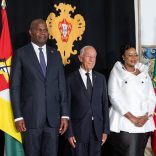Barcelona renews confidence in Maputo through metropolitan cooperation agreement
Mozambique: Agreement with creditors raises debt to 101% this year – Fitch

File photo: Lusa
The financial rating agency Fitch on Thursday said that the resolution of Mozambique’s sovereign debt, together with the accumulation of domestic foreign debt, will raise the public debt ratio to 101% of GDP this year.
“We anticipate that public debt, excluding guaranteed domestic debt, will increase from 97% of GDP in 2018 to 101% this year, due to the higher payment on Ematum sovereign debt, the accumulation of foreign arrears and the rise in domestic debt,” Fitch analysts wrote in a report on ratings in sub-Saharan Africa.
In the document, sent to clients and to which Lusa had access, Fitch pointed out that the two loans from ProIndicus and Mozambique Asset Management (MAM), worth $1.2 billion, continue to be a vulnerability for the government, representing 13% of the debt, including interest arrears in 2018 and adds that the government may challenge the MAM loan in court, as it has already done with ProIndicus.
Last week, the government said that it had made the payment due by the end of October, fulfilling the necessary conditions to stop being in financial default concerning the creditors of the $726.5 million issued in 2016, which result from the conversion of the bonds of the Mozambican Tuna Company (Ematum).
Fitch anticipated that Mozambique’s economic growth will slow this year to 1.8% and then recover to 5% in 2020, driven by reconstruction efforts following cyclones Idai and Kenneth, while public debt, after rising to 101% this year, should fall to 94% and 90% in the following two years.
Fitch said that at a regional level, public debt in sub-Saharan Africa should stabilise at 56% this year, which compares with the forecast of 83.8% for Angola, 123% for Cabo Verde and 100.7% for Mozambique, the three Portuguese-language countries analysed by Fitch Ratings.
The rise in debt combined with a growing recourse to commercial debt and debt issues has caused sub-Saharan African countries’ spending on debt interest to have risen to an average of 13% in 2019, with five of the 19 countries analysed with a ratio above 20%, which suggests that there is a limited margin in the event of a shock, analysts said.
Among the 19 countries analysed by Fitch, three have a Negative Evolution Perspective, one has a Positive Evolution Perspective and all the others have a Stable Evolution Perspective.
Fitch expects growth of 4.1% this year, slightly above the 4% of 2018, and expects a slightly higher growth in 2020, estimating that the two largest African economies, Nigeria and South Africa, have a growth in line with that of last year, and anticipate that Angola can simply avoid a new contraction of GDP in 2020, with the rest of the region dividing itself between importers of raw materials, which will have a rapid growth, and a group of exporters of these materials that are still recovering from the shock.












Leave a Reply
Be the First to Comment!
You must be logged in to post a comment.
You must be logged in to post a comment.